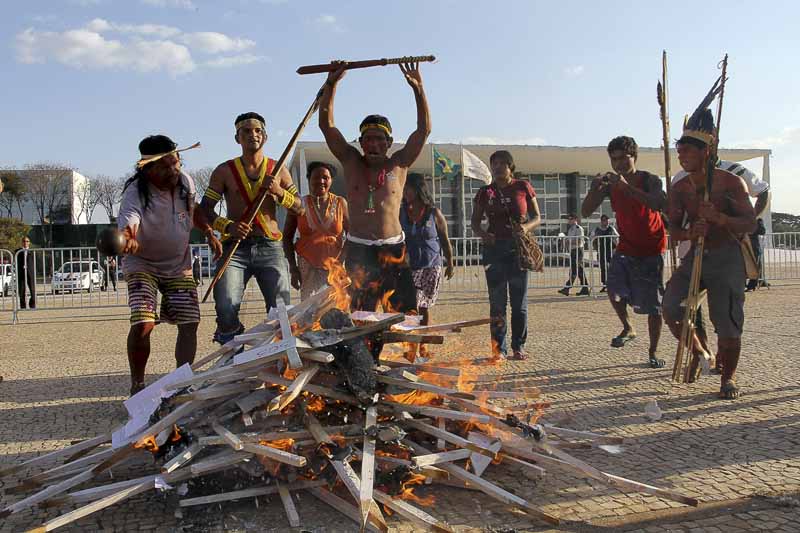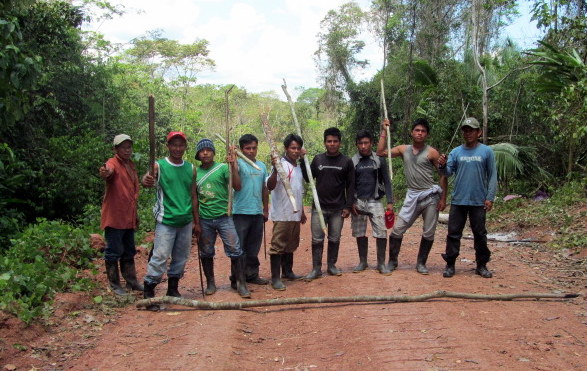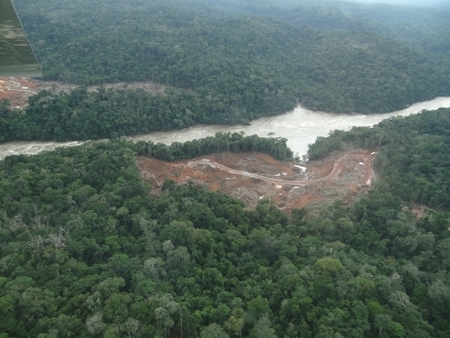
by Deep Green Resistance News Service | Oct 10, 2012 | Lobbying, Toxification
By Jeff Gray / The Globe and Mail
Chevron Corp. has lost a bid to have the U.S. Supreme Court consider its call for a worldwide ban on attempts to collect on a controversial $19-billion (U.S.) environmental judgment levelled against the company in Ecuador.
The decision comes with lawyers in Canada poised to battle in a Toronto courtroom next month over an attempt by the Ecuadorean plaintiffs to seize Chevron’s considerable Canadian assets to cover at least part of the massive judgment – a judgment the oil giant dismisses as fraudulent.
In the latest twist in a tangled legal saga, Chevron was trying to revive a preliminary injunction issued last year by a federal judge in New York. That injunction was later overturned on appeal. It purported to block the plaintiffs and their lawyers from trying to enforce the 2011 Ecuadorean court ruling not just in the U.S., but anywhere outside of Ecuador.
The U.S. Supreme Court refused on Tuesday to hear the case. It issued no reasons, as is customary, leaving the appeal court decision that quashed the injunction in place.
The news comes as lawyers for the plaintiffs – a group of villagers in the Amazon rainforest – have stepped up their campaign to force the oil company to pay for environmental damage from oil pollution in the Lago Agrio area of Ecudaor.
Chevron, based in San Ramon, Calif., has said it has virtually no assets remaining in Ecuador, and the plaintiffs have vowed to chase the company’s assets elsewhere. Their first stop, earlier this year, was Canada.
In May, they announced they had retained prominent Toronto lawyer Alan Lenczner, of Lenczner Slaght Royce Smith Griffin LLP, to try to have the judgment recognized by the Ontario Superior Court and force Chevron to fork over its Canadian assets, which include oil sands holdings. The plaintiffs have also filed a similar collection effort in Brazil.
In sprawling litigation in the United States, both sides have accused each of fraud and bribery in connection with the Ecuadorean ruling, allegations they both deny.
Chevron said Tuesday in an e-mailed statement that the company was disappointed with the decision but “will continue to defend against the plaintiffs’ lawyers’ attempts to enforce the fraudulent Ecuadorean judgment, and to further expose their misconduct in our pending [litigation] in New York and other proceedings.”
The plaintiffs’ say the ruling is the latest in a series of defeats for Chevron in U.S. courts.
“Chevron’s latest loss before the Supreme Court is an example of the company’s increasingly futile battle to avoid paying its legal obligations in Ecuador,” Aaron Marr Page, a lawyer for the Ecuadoreans, was quoted as saying in an e-mailed statement.
Read more from The Globe and Mail: http://www.theglobeandmail.com/report-on-business/industry-news/the-law-page/chevron-loses-bid-to-have-ecuador-case-heard-by-us-supreme-court/article4599707/

by Deep Green Resistance News Service | Oct 9, 2012 | Biodiversity & Habitat Destruction, Colonialism & Conquest, Indigenous Autonomy, Obstruction & Occupation
By Jeremy Hance / Mongabay
Construction on Brazil’s megadam, Belo Monte, has been halted again as around 150 demonstrators, most of them from nearby indigenous tribes, have occupied the main construction site at Pimental. Over a hundred indigenous people joined local fishermen who had been protesting the dam for 24 days straight. Indigenous people and local fishermen say the dam will devastate the Xingu River, upending their way of life.
“The renewed occupation of the project’s earthen cofferdams paralyzed construction works, while indigenous protestors seized the keys of trucks and tractors forcing workers to leave the strategic Pimental work camp on foot,” reads a press release from the NGO Amazon Watch. Around 900 workers were sent home.
This is the second occupation attempt in less than six months. Over the summer some 300 indigenous people sustained an occupation of the dam for 21 days, before breaking it off though little headway was made in talks with consortium building the dam, Norte Energia.
The Belo Monte dam, which would be the world’s third largest, has been plagued by controversy from its origin decades ago; the battle for the dam has been fought both in Brazil’s courts and on the international stage. If built, the dam will flood an estimated 40,000 hectares of present rainforest and could push some fish species to extinction. In addition, 16,000 people will be displaced according to the government, though some NGOs say the number is more likely double that.
Despite the impacts, the dam has been strongly supported by Brazilian President Dilma Rousseff, and every legal injunction against the dam has been overturned. Norte Energia has filed with a local court for repossession of the construction sties.
Indigenous groups say the construction of the dam is already imperiling their way of life, as the Xingu river becomes more difficult to navigate. They have also said they have no intention of leaving until Norte Energia meets their demands.
“We are witnessing the devastation of this land. The island of Pimental was completely destroyed, with a sole tree left standing, and the water is putrid. It is very shocking,” an protestor told Amazon Watch.
Dams are often described as ‘green’ energy source, however in the tropics they actually release significant methane emissions due to rotting vegetation. Although it has a shorter life than carbon, methane is a far more potent greenhouse gas.
From Mongabay: “Indigenous groups re-occupy Belo Monte dam in the Amazon“

by Deep Green Resistance News Service | Sep 10, 2012 | Indigenous Autonomy, Mining & Drilling, Obstruction & Occupation, Toxification
By Ronald Suarez, Network of Peruvian Indigenous Communicators, Ucayali
Over 400 villagers in the Native Community of Canan de Cachiaco in the Ucayali region of the Peruvian Amazon have taken control of nine oil wells, belonging to oil company, Maple Gas, in oil lot 31B.
Community members took over the oil wells on September 2nd, and continue to hold them as a result of 37 years of oil contamination in their territory by the company.
The community leader, Basilio Rodriguez Venancio, said the action was made necessary because the company did not consider the environmental impact assessment carried out by an independent consultant.
The community is demanding that the company pay them compensation for the use of their lands and for the environmental damage they have suffered for 37 years. Such damage includes the contamination of their rivers, their only source of drinking water, and the contamination of their soils due to the company’s use of chemicals and heavy minerals, which the population says has significantly affected the productivity of their land.
Several community members testified that they have become sick due to the company’s negligence and contamination of their drinking water. There have been several instances in the past years of cancer and ¨unknown deaths¨ that the community attributes to company abuses.
The community awaits the arrival of state representatives from the Ministry of Energy and Mines and Ministry of Environment, scheduled for Thursday, September 13th, to resolve this conflict.
Meanwhile the villagers are still stationed in the camp until authorities settle their claims.
From Alianza Arkana

by Deep Green Resistance News Service | Aug 26, 2012 | Biodiversity & Habitat Destruction, Colonialism & Conquest, Indigenous Autonomy, Lobbying
By Fabiola Ortiz / Inter Press Service
The Sete Quedas or “seven waterfalls” on the Teles Pires River, which runs through the Amazon rainforest states of Mato Grosso and Pará in central Brazil, are a spiritual oasis venerated by several indigenous groups.
But the 20-metre-high rocky falls are to be covered by a reservoir created by a hydroelectric dam that is to flood an area of 95 square km.
“It’s a sacred area, our creator and mother. And the ‘pajé’ (shaman) says it is where the fish lay their eggs,” João Kayabi, 52, told IPS by phone from the area. He is the chief of Kururuzinho village, home to 106 members of the Kayabi community, who speak a Tupí-Guaraní language.
For the Kayabi, the area around Sete Quedas must be left untouched, because it is the dwelling of a god who is responsible for the natural balance.
“It will be left underwater, and will only be a memory. We are trying to keep that from happening,” Kayabi said.
Sete Quedas is also sacred to two other indigenous communities: the Apiaká and the Mundurukú. For the latter, the falls are “the mother of fish” and the dwelling-place of their ancestors.
“The Mundurukú say the river is going to dry up, there will be a shortage of food, and the fish will vanish. I hope that isn’t so,” Kayabi said.
Studies on the biodiversity in that stretch of the river, carried out by Brazil’s Energy Research Company (EPE), which conducts research for the Ministry of Mines and Energy, have identified nearly 700 plant species and more than 200 species of fish, such as the spotted sorubim (Pseudoplatystoma corruscans) catfish, the common dolphinfish (Coryphaena hippurus), and the jau (Zungaro zungaro) catfish.
The Teles Pires has the reputation of being one of the world’s best rivers for fishing.
In the indigenous territory where João Kayabi’s village is located, nearly 300 people make a living from hunting, fishing and harvesting fruit.
“Up to now, our land has provided for us sufficiently. But we are concerned about what will happen in the future, and whether food will be scarce,” said the chief, a father of seven. “I’m worried about my children; I don’t know what will become of their lives.”
The Teles Pires plant will have a generating capacity of 1,820 MW. But the Companhia Hidrelétrica Teles Pires, the company that was granted the concession for building the dam, is fighting a judicial battle to be able to finish construction.
The project collides with the beliefs, customs and traditions of the Kayabi, Mundurukú and Apiaká Indians (a combined total of 12,000 people), said indigenous rights lawyer Juliana de Paula Batista, who advises native organisations in Brazil’s southwest Amazon region.
The case has been winding its way through the courts. In early August, a regional federal court ordered suspension of construction of the dam. But the attorney general’s office and Brazil’s environmental protection agency IBAMA appealed, and the suspension was lifted on Aug. 14.
“The natural resources that are indispensable for indigenous people to sustain their lifestyle and culture are being plundered,” Batista told IPS.
Early this year, the office of the public prosecutor brought a civil lawsuit to revoke the environmental license granted by IBAMA in August 2011 and bring construction to an immediate halt.
According to Batista, the environmental licensing process is flawed. “At no time has the magnitude of the impact on indigenous lands been fully understood.”
“The dam endangers fish stocks, the sacred site, water quality, rare and endemic species, vegetation in general, and hunting,” the lawyer said.
Although the tribes will not have to be relocated, they are afraid to remain in their villages “because in case of accidents, such as a break in the dam, the water would carry them away,” Batista said.
The Kayabi villages are only 50 km from the dam.
“There is no solution when it’s a government plan, we have no way to fight this,” Kayabi said. “The only way is to seek support and guidance. The dam will be built, and we are the ones who will be hurt by it, we could lose our rights.”
One of the irregularities noted by the office of the public prosecutor was the company’s failure to consult with the affected indigenous communities prior to the start of construction, as required by law. In March, work on the dam had already been suspended in response to the prosecutors’ request.
Read more from Inter Press Service: http://www.ipsnews.net/2012/08/hydropower-dam-to-flood-sacred-amazon-indigenous-site/




